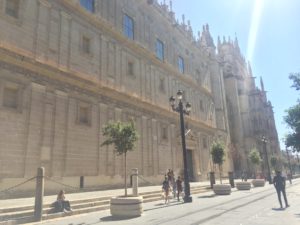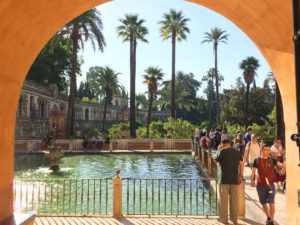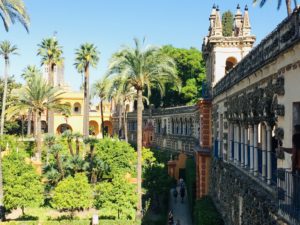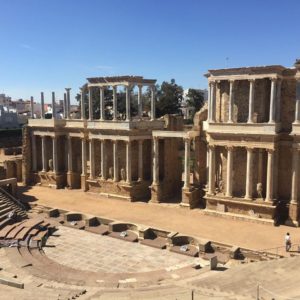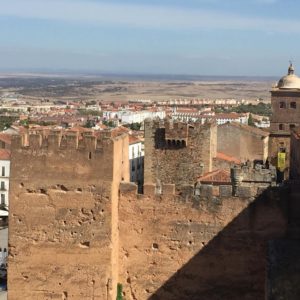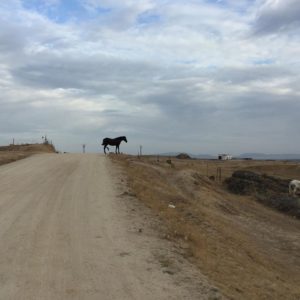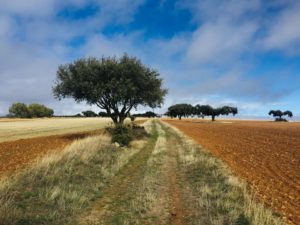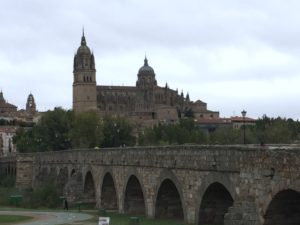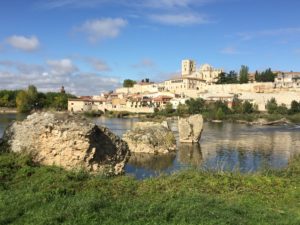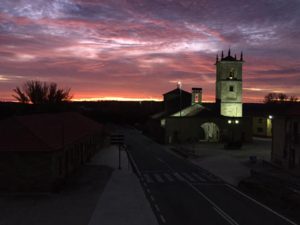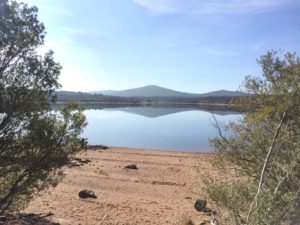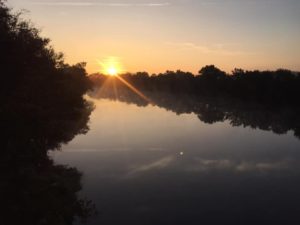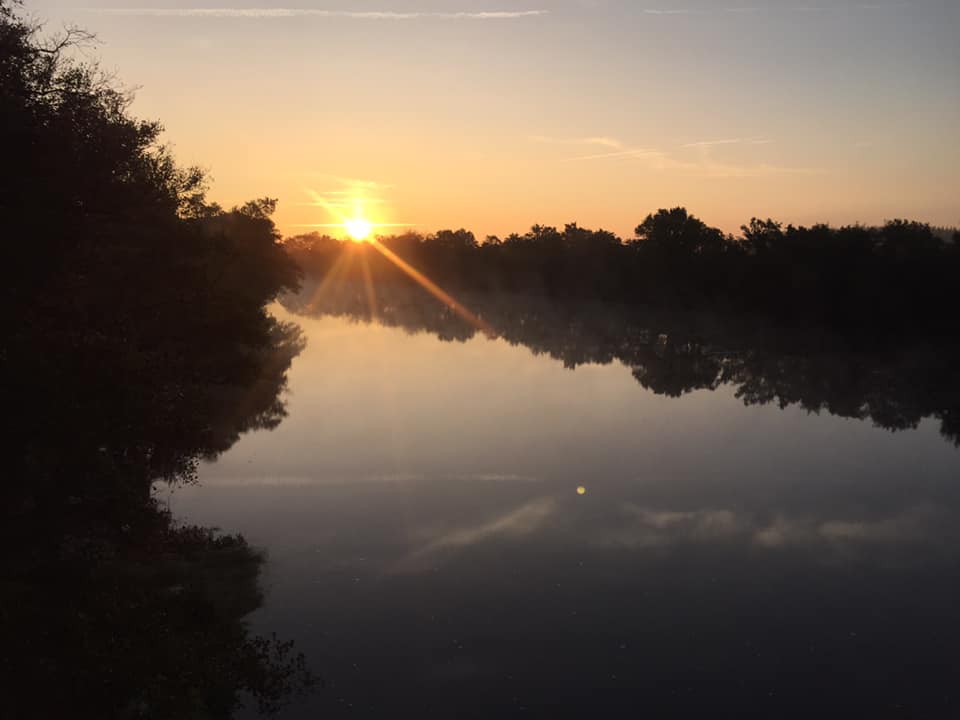VIA DE LA PLATA
40 DAYS IN THE DESERT
Nobody who decides to undertake a Camino is entirely sane, but those who choose to walk the Via de la Plata fall into the category of certifiably mad. Who in their right mind would want to walk 1,000 kilometres from Sevilla in the heartland of Andalucia all the way through some of the most isolated parts of Spain to reach the resting place of the apostle? The Via de la Plata is one of the longest pilgrimage routes, with a very small number of pilgrims, which passes through some of the most remote locations on the Iberian peninsula, yet for all these challenges it is one of the most rewarding and mesmorising walks. Unlike the Camino Francés, which is increasingly become a victim of its own success, the Via de la Plata remains a true pilgrimage, a challenging test of body and mind, which will usher its participants through some of the most hauntingly beautiful parts of Spain and give them an experience unlike many to be found in the modern world.
The magnificent Moorish metropolis of Seville, with its UNESCO listed cathedral and Alcazar, is the starting point for this epic journey. Once out of this bustling city, the pilgrim enters a more timeless world, where the pace of life is slower, archaic Spanish time rules the running of shops and businesses, and isolation is one of your more frequent companions. Picturesque white villages and cork oak forests form the backdrop of the journey through the province of Andalucia, where the first few days of this camino are spent, before crossing into the province of Extramadura. Translating into English as extra hard, this is a quiet arid region of olive groves and scrub lands, with the enchanting Roman cities of Merida and Caceras providing some fascinating historical sites. Many of those who became conquistadors in the new world left this region the 16th century because of its unforgiving environment. Extramadura remains a challenging land today, and younger generations have also moved on to other places in search of a more prosperous life. It is not unusual to walk for hours in these parts without seeing another person. Depending on your pace, it can take up to two weeks to cross Extramadura. In Autumn, the land is burnt to an auburn crisp from months of heavy sun, but the relative flatness and significant stretches along off road tracks makes it pleasant walking.
Beyond Extramadura comes a hike up to the high plains of the Meseta, which takes about another two weeks to cross. This expansive flat land of cereal fields makes it Spain’s granary. Its countryside is now vastly depopulated, with the average age of many people living in villages being of retirement age. For sale signs and decrepit buildings are as common as people in the small sleepy villages along these parts. Walking is easy in this flat land, but its elevation brings harsh winds and cold temperatures, especially at night time. Bringing extra layers of clothing is advisable for these parts. I didn’t and regretted that, although I did survive to tell the tale. The cities of Salamanca, with the oldest university in Spain, and Zamora, which bristles with Romanesque jewels, are two of the biggest highlights in this section. Salamanca is roughly at the halfway point along the Via de la Plata, and is a good place to spend an extra night given that the city has so much to offer. No harm in recharging the batteries a little for the next 500 KM.
Shortly after Zamora the route spilts in two. Pilgrims have the option to head to Astorga and connect up with the Camino Frances, or continue along a new path known as the Camino Sanabres for the remainder of the journey to Santiago. I opted for the latter. The Sanabres has many pockets of great beauty, as the landscape moves from the Meseta into the mountains, and across into the lush rainswept region of Galicia. Stages are often quite long here, with 30 KM and more not being unusual. Places to resupply can be limited, and at times it can feel a little like the land that time forgot, yet the frequent detours caused by the construction of the high speed train AVE is a reminder that the modern world is never very far away.
The city of Ourense is the only major city on this stretch. It is famous for its natural warm baths, and is a good place to soak your bones (because at this point that’s all you will be) before completing the final 100 KM to Santiago. The weather can be temperamental in these parts, so be prepared to get wet, but when you finally arrive into Santiago you will feel that all the challenges you have endured on this epic journey have been worth while.
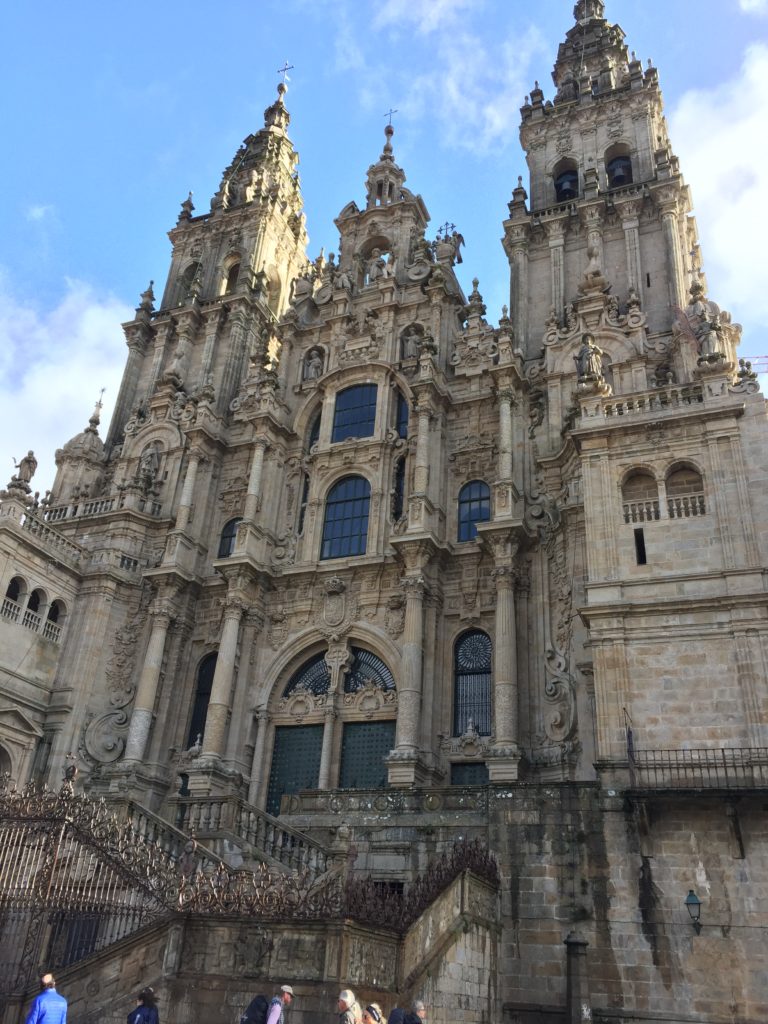
THE STAGES
I walked the Via de la Plata and Camino Sanabres in the Autumn of 2019. Beginning in the relative heat of Seville on September 30th, I reached Santiago on November 5th, taking just one day of rest, in Salamanca, along the way. Spring is considered to be the most pleasant time to walk this path, as all the flowers are starting to come into bloom. By autumn most of the earth is scorched, and the harvests have already been reaped, but temperatures for walking are quite comfortable. The cold in the Meseta proved to be more of an issue for me than the heat in the south. Summer is to be avoid unless you really want to punish yourself. Accommodation along the way is of good quality, but you often need to walk 30 KM to find a bed for the night. Shops are less frequent than on other routes, so be sure to stock up when you find one. The Via de la Plata is one of the least walked of all the caminos, and those who do it are usually seasoned veterans of the Ways of St. James. That said, for the adventurous and industrious it is a glorious walk and an unforgettable journey.
A fairly easy day to begin with. The camino begins outside the Cathedral, then heads across the Guadalquiver into the suburb of Triana. It’s not long before you’re out of the city and into the countryside. It becomes very isolated very quickly, and the path follows through olive groves and cotton fields before arriving in the pleasant town of Guillena, which has a very welcoming private albergue, a decent supermarket, and a restaurant which, like most Spanish restaurants, doesn’t start serving dinner until later in the evening.
Another short, easy and fairly flat day, through quiet scrub and farm land. The terrain and scenery are pleasant on both the eyes and the feet. There’s a very friendly public albergue in Castileblanco, and the town has a good selection of shops, cafes and restaurants, but here it becomes apparent how inconvenient serving hours are in Spanish restaurants, with most not offering food before 9 PM. Eating your main meal in the middle of the day may be a more suitable option.
A longer stretch today, with the first half of the journey along a road, albeit a fairly quiet one. Then the path crosses the Parque Natural Sierra Norte, where the dusty paths and forests of cork oak make for pleasant walking. There’s a fairly savage hill towards the end of the stage before descending into the pretty village of Almaden, which has a good selection of albergues as well as a decent restaurant and shop.
A long stage today, which sees us cross from Andalucia into Extramadura. The landscape changes quite starkly from forests of cork oak into wide expanses of farm land. The walking is flat for much of the day, but there’s a bit of a climb towards the end to the town of Monasterio, which has a good selection of lodgings and facilities. The village of El Real de la Jara, 14 KM from Almaden, is an alternative stopping point if you’re looking for a shorter day.
Today’s walk is a mesmorising trip through the barren wilds of Extramadura. Wide expanses of sheer emptiness greet the pilgrim. The pleasant town of Fuente de Cantos after 21 KM is the normal stopping point, but the main albergue was closed when I was there so I went a further 6 KM to the town of Clazadilla de los Barros, which has alternative accommodation.
A short and relatively easy stage today brings us to the very pleasant town of Zafra, whose town centre is well worth exploring. This town has lots of shops and facilities, but due to erratic Spanish business hours may not be open when needed. There’s a lovely albergue here in an art nouveau house.
Another short day, mostly through farm lands, though there is a small stretch later on by train tracks and under motorways. Villafranca is an appealing town with a selection of accommodation and facilites.
A long, straight and very flat section, through olive groves and vineyards. The walking is easy today, and the small village of Torremejia has a nice albergue and a few shops to resupply on stocks.
A very short day into the small historic city of Merida. Like the walks into many Spanish cities, this walk is in close proximity to busy roads and grim industrial sites. The final stretch into Merida resembles a war zone with its abandoned buildings and burnt out cars. However, Merida is a town with lots to see. Its Roman ruins are very well preserved. Be sure to check out the old amphitheatre, the circus, the aqueduct and the Alcazaba. There’s a friendly municipal albergue near the river.
This is a stage that will really separate the pilgrims from the walkers. The longest stage so far, with the village of Aljucen after 17 KM, the last place to get water before a long but very pleasant slog through a national park.
An easy enough walk today to the village of Valdesalor, a custom designed village from the 1960s. Town has a modern albergue, a few small shops and cafes, but little else.
The shortest of days on the camino, which can be lengthened by 11 KM to the town of Casar de Caceras if preferred, but it’s well worth spending a day in the historic city of Caceres, whose medieval walled city is a UNESCO World Heritage Site. Take advantage of the short day to explore this city, and build up some energy reserves for the longer days ahead.
This is where the real challenge of the Via de la Plata begins. 11 KM after leaving Caceras is the town of Casar de Caceras, but beyond that there is nothing until you reach Emblase de Alcantara 22 KM away. The hostel here is often closed, so it’s often necessary to go a further 10 KM to Canaveral, where a very comfortable albergue awaits. There is nothing but wilderness after Casar de Caceras, so be sure to stock up on food and water. The walking is quite pleasant, with the camino crossing the Rio Tego and running near the a massive reservoir.
Another very long stage, with the option to cut it short by 11 KM in the picturesque walled town of Galisteo. Pleasant hilly woodland walking at the start of the day, followed by a long stretch along a road to Caracaboso. The scenery changes quite dramatically along here, as the arid land gives way to much more green and verdant surroundings. A selection of albergues in Carcaboso, along with shops and other facilities.
An odd day this. There’s no albergue on the camino for 39 KM, but there are the options of taking detours to Oliva de Plasencia (18 KM for Carcoboso) or Hostal Asturias (28 KM from Carcabosa) to shorten the day. If you decide to stick to the main camino ensure you have enough food as there is very little else along this long road. The old Roman city of Caparra at the halfway point of today’s stage is a place of significant historical interest, and also a place with vending machines to get water. Aldeanueva is a pleasant little town with a few albergues and small shops.
A short stroll in comparison to the previous days, although there’s quite a climb following the beautiful town of Baños de Montemayor. Today we leave Extramadura and cross into Castilla Y Leon. There’s a lot a of woodlands on this stretch, with views of mountains in the distance. The small village of Calzada de Bejar has a welcoming albergue, but not a whole lot else.
Another short day, through quiet, rugged countryside, with some pleasant scenery to keep you occupied. We finish today in the sleepy village of Fuenterroble, which has a very comfortable albergue in a monastery of sorts. The dorm has a wood burning stove, which is a welcome feature to combat the cold evenings.
There’s a solid climb on today’s walk, up to 1,145 metres, which is the highest point so far on this camino. The path crosses through moors before the ascent, then follows along quiet roads and through farmland on the other side. This is the beginnings of the Meseta, which will take about ten days to cross. The small town of San Pedro de Rozados after 28 KM is the main stopping point on today’s stage, but 4 KM after that is a nice alternative albergue in the village of Morille. Going the extra 4 KM shortens the walk into Salamanca the following day.
We’re now at roughly the halfway point, and Salamanca is a perfect place to spend an extra night if you want to recharge your batteries. Sporting one of Spain’s oldest university, two cathedrals, a magnificent main plaza, and a whole host of other cultural and historical jewels, Salamanca is the biggest city along the Via de la Plata and it’s worth spending an extra night here to explore it’s charms.
The walk out of Salamanca is relatively painless, and the today’s journey is long and a bit monotonous, and follows a path running parallel to the main road for most of the day. Despite the distance, the walking is flat and relatively easy, although there isn’t much along the way. Be sure to stock up in Salamanca before leaving. El Cubo de Vino has a private albergue that does dinner, and there are also a few other facilities in the village.
We’re now into the real heart of the Meseta, where today’s path crosses through oceans of cereal fields. It’s a hauntingly beautiful walk, but also very isolated, with the village of Villanueva being the only sign of human habitation along the way. Zamora is a lovely little city, and it’s old town contains a number of beautiful Romanesque churches, and a cathedral which boasts a variety of different architectural styles. The municipal albergue here is one of the most comfortable and welcoming on the whole camino.
A very short and easy stage after two long days. We encounter the first stretches of the newly constructed AVE train tracks along today’s walk. Montamarta is a pleasant if sleepy little town, with a shop, cafe, and an albergue that has been converted from an old school house. Later in the year it can get pretty cold in the night.
Another short and relatively easy day, that involves crossing a dry reservoir and passing an abandoned fortress from ancient times. A lot of today’s path runs parallel to a main road, but the walking conditions are generally pleasant. Granja is a small town with a good albergue, a cafe and a little shop. It is here that the route splits in two, with the options being to walk to Astorga and join up with the Camino Frances, or take the alternative path and head in the Ourense along a route called the Camino Sanabres. It is the stages of the Sanabres I will be subsequently describing.
Today is the first day of the Camino Sanabres, and it’s a magnificent beginning to this journey. We cross the Rio Esla river, and walk along its banks for a while, before returning to the vast flat cereal fields of the Meseta. Today’s is an easy walk, with little opportunity for human contact, and the day finishes in the small town of Tabara, where a unique and welcoming albergue awaits.
A long and lonely walk through scrub land, emerging later into pockets of forestry, today’s walk runs mostly along dirt tracks and far from civilisation. The landscape changes quite substantially towards the day’s end as we walk along the lush banks of the Rio Tera. The village of Santa Marta de Tera has a few cafes and a small shop, and a modern well equipped albergue. The local church has what is believed to be the oldest statue of Santiago.
A beautiful symphony of different landscapes on this stage, as the path passes by poplar forests, cornfields, canals and dams. There’s lot of water features today, which contrast with the more arid conditions generally found in these parts. The village of Calzadilla de Tera is the only place en route to find a shop, although there is an excellent restaurant and albergue in Rionegro
A very long stage, mostly through woodlands and along dirt tracks and quiet roads. The town of Mombuey after 9 KM is one of the only places to resupply, though it is advised to avoid the albergue there at all costs. Asturianos after 26 KM is an alternative stopping point. There are many small villages along this stretch but there is little life or activity in any of them. The tourist town of Puebla de Sanabria has a magnificent medieval castle, along with all other necessary facilities.
Today we face a substantial climb to over 1,300 metres, and due to the construction of the high speed AVE train much of the walking is on the hard shoulder of a busy road. While the presence of heavy traffic is a drawback, the scenery is splendid as we leave the flat plains of the Meseta behind and cross into the mountains that separate Castilla y Leon from Galicia. There’s a cosy little albergue in the pretty village of Lubian.
Some challenging hills on today’s walk as we leave Castilla y Leon behind and cross into Galicia. The landscape and architecture change very dramatically, and the stone corn stores, know as horreos, dot the green and rugged landscape. Be prepared for lots of rain in these parts, but enjoy the lush bucolic scenery as well. A Guidina is a small town with all facilites.
A long and lovely walk, with many challenging ascents and descents, but some stunning scenery along the way. There’s a mixture of quiet roads and forested pathways on this section. Campobecerros, after 20 KM,, offers alternative lodgings for the night. Laza is a fairly non descript town with a nice albergue and all necessary conveniences.
Another long stage, with a very challenging climb early on, but some beautiful scenery en route. The camino winds its way through forests and farmlands, with the village of Vilar de Barrio after 20 KM providing a resting place and shops. Be careful of the apiary in the latter stages, as wayward bees have a tendency to sting unsuspecting pilgrims. Xunqueria has a good municipal albergue, and the town has an impressive church and cloisters, along with shops, cafes and restaurants.
A short stage today, much of it near busy roads and through drab industrial estates as we head into the city of Ourense. A major urban centre can come as either a shock or a relief after the tranquility and isolation of previous days. The roman bridge Ponte Vella and the cathedral are two of the city’s major attractions, and be sure to avail of one of the Ourense’s famous thermal baths. There is one located just around the corner from the new and comfortable albergue.
The last of the long days, which can be shortened substantially by stopping in the town of Cea. The Camino splits in two as you exit Ourense. I opted for the right hand route, which begins just after crossing the old Roman bridge out of Ourense. There’s a serious climb for the first few kilometres, but the road levels out after that and drifts along through quieter countryside and small villages. After Cea the route splits again, with the longer right hand option passing the Monasterio de Oseria. I took the sightly shorter left hand path. There’s a nice albergue in Castro do Dozon, with a kitchen attached.
After what seems like an eternity, Santiago now seems tantalisingly close, as road signs indicate diminishing distances. Today’s walk has chunks along busy roads and other parts through quiet countryside. There’s a lovely stretch through a forestand across a gorge towards the day’s end. Silleda is a sizeable town of no major distrinction. There’s a range of accommodation, but not all of them are open year round.
Lots of lush countryside await at the earlier part of today’s walk. The town of Bandeira after 7 KM has all necessary facilities. There’s a lot of quiet woodland walking afterwards, followed by a steep descent to the town of Ponte Ulla. Some people choose to stay here for the penultimate night of their journey, but if you’d prefer a shorter walk to Santiago the next day then carry on for a further 4 KM, much of it uphill, to Outeiro, which has a nice albergue. Be sure to stock up on supplies in Ponte Ulla as there is nothing in Outeiro apart from the albergue.
Much of today’s stage is pleasantly rural and quiet, in spite of its close proximity to our destination. We don’t catch sight of Santiago until we reach its fringes, and shortly thereafter the cathedral then comes into view. It can be quite overwhelming to see its spires after such a long time on the road. The path is quite well way marked in the city’s suburbs, but as you get closer to the centre the arrows are less frequent. However, it’s quite easy to get to the cathedral once you reach the old town. Make your way to Plaza do Obradoiro in front of the cathedral, pose for the obligatory photo, and breathe in the satisfaction of having completed the Via de la Plata – one of the longest and toughest pilgrim paths to Santiago. Well done, pilgrim!
